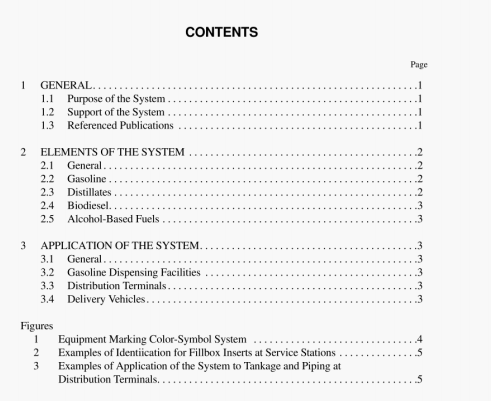API RP 1637:2006 pdf download.Using the API Color-Symbol System to Mark Equipment and Vehicles for Product ldentification at Gasoline Dispensing Facilities and Distribution Terminals.
2.1.3 Superimposed crosses. bars and alpha-numeric designations for product names are used to further distinguish products.
2.1.4 Vapor-recovery connections and manholcs are marked with orange circles. The gasoline symbol, the circle, is used because the principal environmental concern is with gasoline vapors.
Note: Used oil is identified by a purple square. White lettering may be used to supplement the marking sysiem.U.S. EPA’s Used Oil Management Standards (44) Code of Federul Regu!atinn.c. Section 279 provide .idditional labeling requirements for used oil storage at generator, transfer. or processing and refining facilities.
2.1.5 Cons jstcnI with API Recommended Practice 1615. monitot-ing or observation wells are identified with a black equilateral triangle on a white background.
2.2 GASOLINE
2.2.1 All gasoline is identified with a circular marking. The marking system does not attempt to classify all the gasoline manuflictured by all the companies that operate refineries. At least five grades of unleaded gasoline are marketed under such names as super premium. premium. mid-regular. regular. and sub-regular. In addition. octane can vary by geographical location, season of the year. and refinery batch. The marking system provides for three grades of unleaded gasoline. The gasoline with the highest octane is marked red, the one with the lowest octane is marked white, and any imennediate grade is marked blue. This arrangement may present a problem in cases in which product is exchanged between two companies, where one company markets three grades of leaded gasoline and the other markets only two. In such cases, product names, octane ratings. or brand code numbers should be used to supplement the marking system. The white crosses on red and blue backgrounds and the black cross on the white background were originally added to identify unleaded gasoline.
2.2.2 Also critical in the transfer of bulk gasoline is the differentiation of neat gasoline from gasoline containing oxygenaIc. This is of particular concern where there are volatility limitations or restrictions regarding the use of such extenders or oxygenates. Most areas require the notation of such oxygenated gasoline in transfer or shipping documents. It is an option for the operator to use the appropriate gasoline symbol surrounded by a white circle to indicate gasoline containing extenders or oxygenates.
2.3 DISTILLATES
2.3.1 All distillates are identified with a hexagonal marking. For low sulfur distillate identification, diesel is yellow. No. I fuel oil is purple with a yellow horizontal stripe. No. 2 fuel oil is green. and kerosene is brown. Grades of diesel fuel and kerosene and grades of fuel oil beyond Nos, I and 2 are not identified. Individual companies may want to use other means of identification to label these products (see 1.2.2).
2.3.2 A blue horizontal stripe is added to the low-sulfur distillate color-code symbols identified in 2.3.1 to identify high-sulfur distillates.
API RP 1637:2006 pdf download
